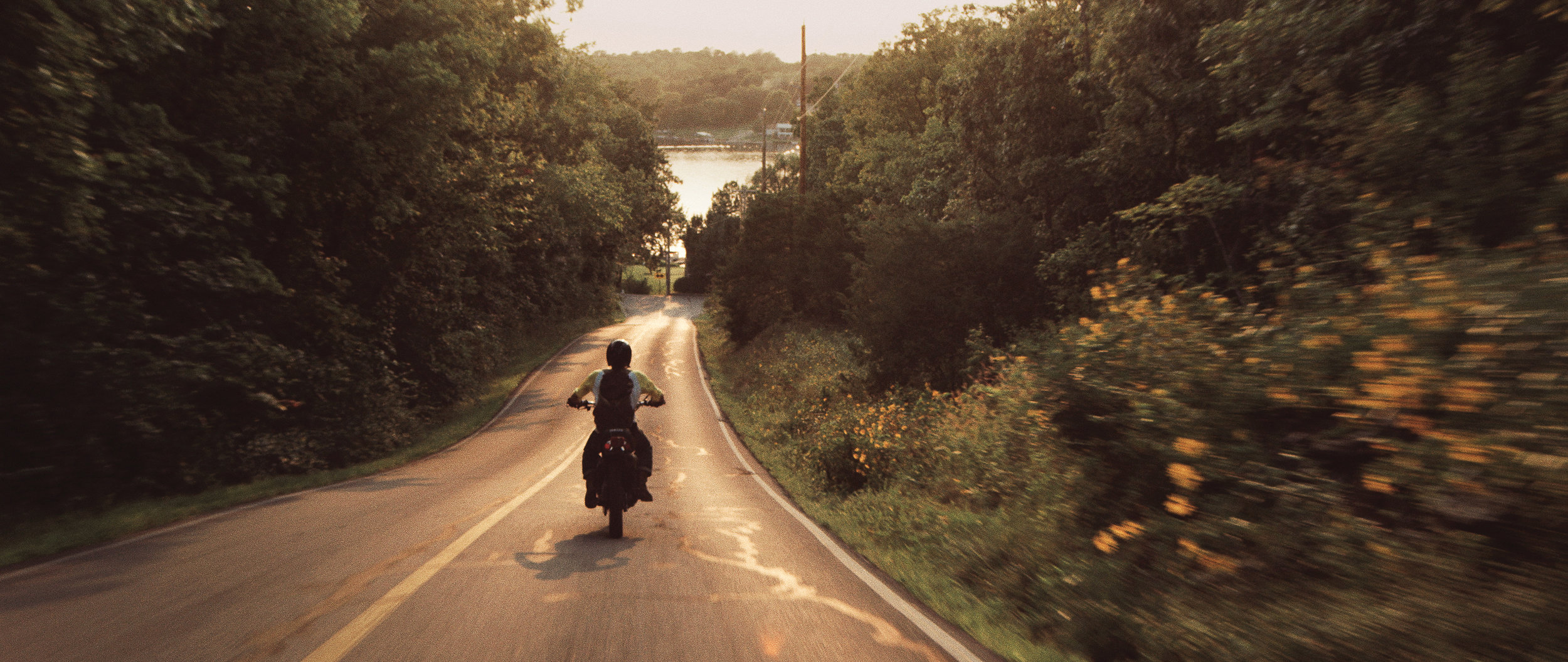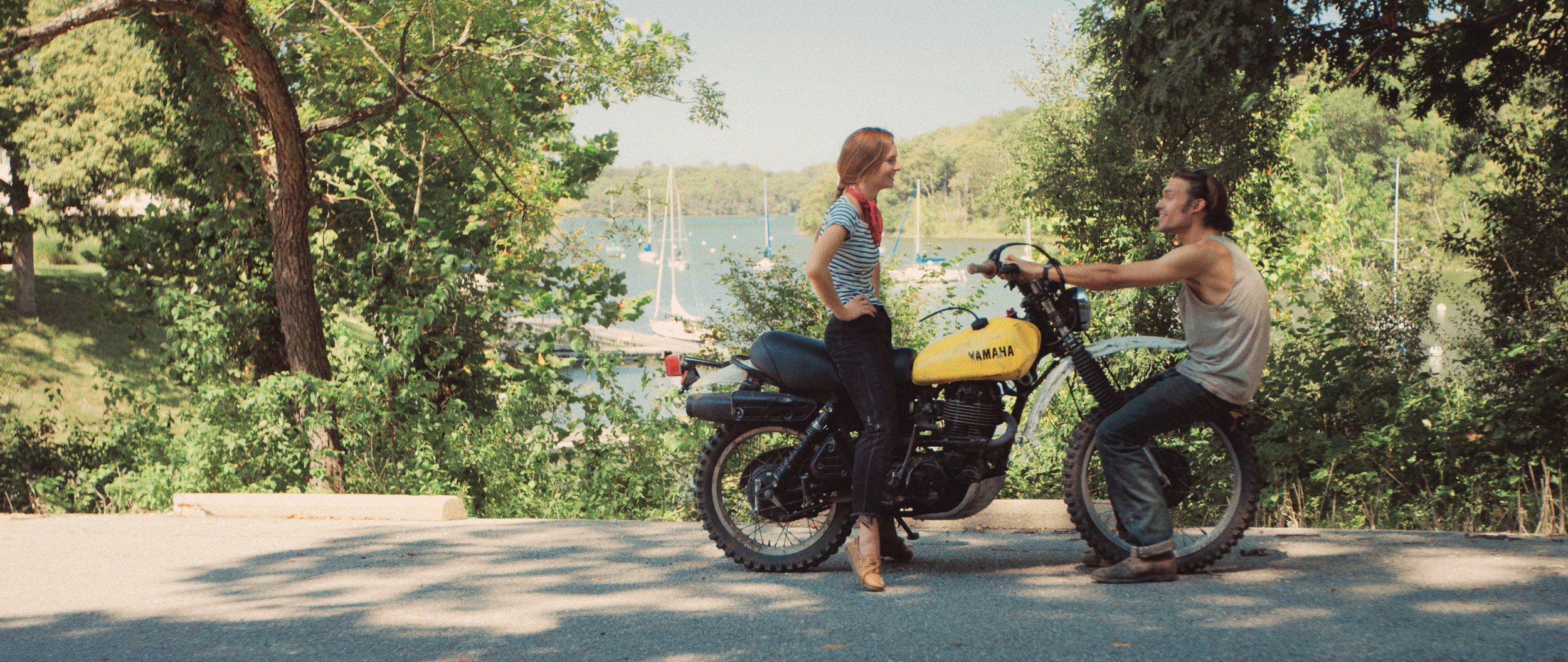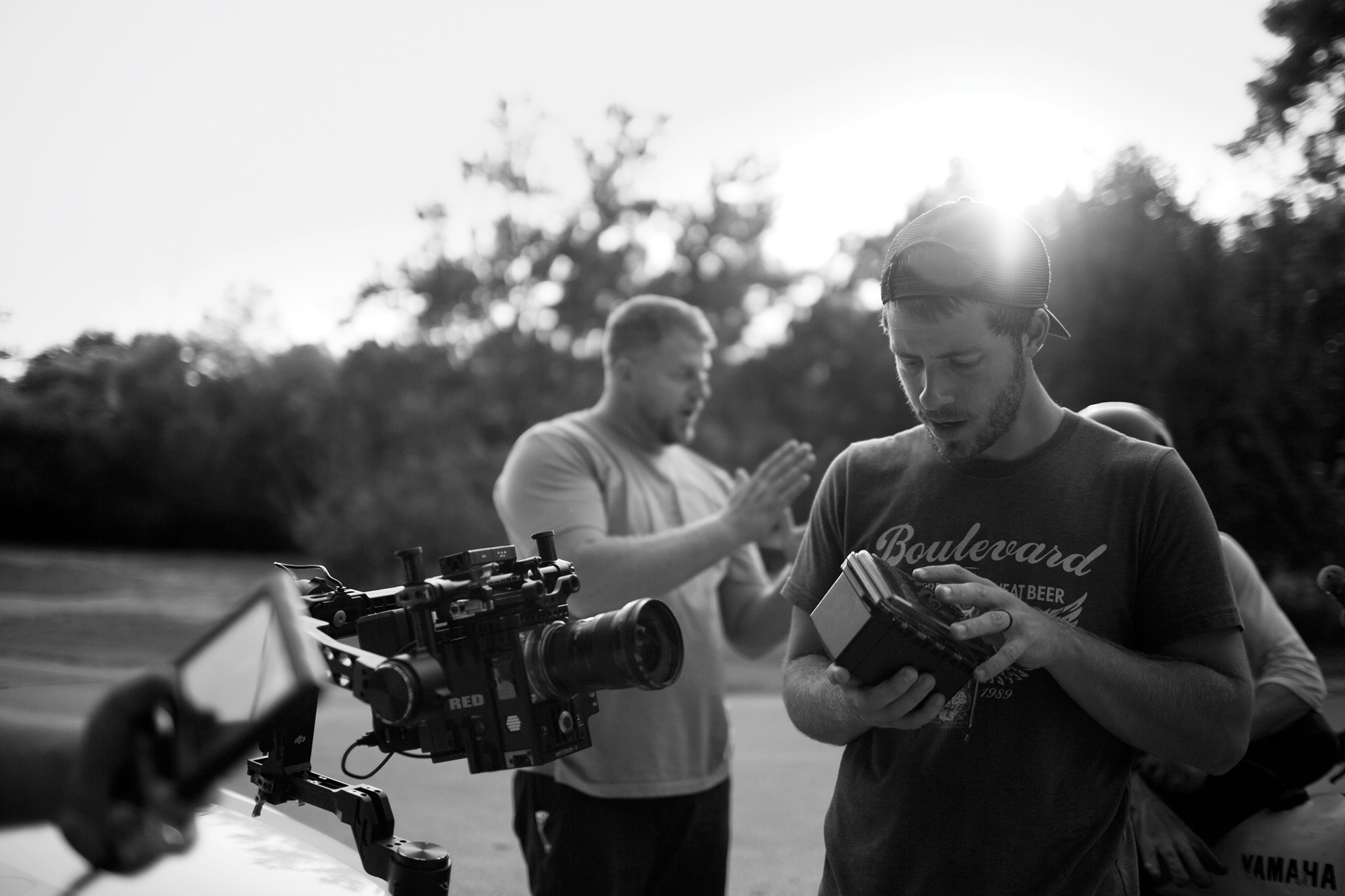Behind the Scenes with Trevor Hawkins & Todd Blubaugh
Interview by Ben Giese
In our idealistic concept of the American Dream, life should be better, richer and fuller for everyone. Our modern Land of Opportunity provides more access to information and greater tools for creativity than ever before, but somehow it has become increasingly more challenging to live outside the box and carve your own path through life. Society has created a strict set of rules to live by and structured guidelines to follow. But does it have to be this way? Do we have to live by this formula and fall into this trap, or can we rewrite our own rules of modern existence?
Filmmaker Trevor Hawkins explores these ideas in his beautiful new cinematic masterpiece, Lotawana. In the feature film starring our friend Todd Blubaugh, empty materialism and the constraints of modern culture have pushed an unfulfilled young man on a voyage of discovery. Escaping to nature by living aboard a sailboat on a rural Missouri lake, he is seeking something more, something beautiful, something real. After setting sail on this journey, he promptly catches wind of a rebellious and free-spirited young woman, and their idealistic dreams align. As they let go, they fall head-first into the ambitious, yet unprepared, idea of leaving their old world far behind.
This is a very relevant conversation for our generation, and Trevor has poured his heart and soul into producing an inspirational film. He has risked everything to follow his intuition, feed his creativity and bring this movie to life.
Complete trust in the path you’ve chosen and confidence in your vision is an admirable thing. Our pal Todd is very much the same – a talented photographer, writer, motorcycle builder, creative thinker and ramblin’ spirit who has even published his own book. I’ve got a tremendous amount of respect for these two and the lives they have chosen, and these admirable traits become self-evident when watching Lotawana.
For Volume 011, I interviewed Trevor and Todd to learn more about the inspiration behind this story, the challenges of independent filmmaking, and how youth, love, rebellion, nostalgia, freedom and wanderlust are woven throughout.
Trevor, what inspired you to want to produce a full-length movie? That’s quite an ambitious undertaking. Is Lotawana your first project of this scale?
Trevor: Movies had never been a big part of my life growing up at the lake, aside from casual passing entertainment. Then one week in high school, my buddy Brian Freeborn showed me Donnie Darko, Requiem for a Dream and A Clockwork Orange down in his parents’ basement, and it changed my life. I remember sitting in the dark after each film ended and thinking to myself, “Movies can do that?” They made me feel things I’d never felt before, and I instantly became obsessed with filmmaking and trying to create emotions for other people through film. From then on, I dreamed of making my own full-length movie and being in production of my first by the time I was 30. Then one day when I was 27, I lackadaisically asked my wife, “How long does it take to make a movie?” To which she replied, “You’d better get started now!” So we met up with our friend and producer Nathan Kincaid, who informed me that we couldn’t start without a script. I went home and Googled “how to write a script,” and immediately started writing what became Lotawana.
Trevor Hawkins | Photo by Tucker Adams
Without spoiling the movie, can you guys tell me a little bit about the story, the concept, the location, the characters, and the inspiration behind all of it?
Lotawana slate | Photo by Nicola Collie
Trevor: Lotawana is based on the real-life Lake Lotawana, Missouri, where I’ve lived my entire life. It made sense to set my first movie here because we could easily shoot for free, and one of the two main characters, Forrest (played by Todd), is loosely based on a younger version of myself. I used to make great efforts abandoning what I perceived as an artificial materialistic culture in favor of a more natural and adventurous lifestyle – much the way Thoureau and [Christopher] McCandless did. I had a dream to sail around the world with a couple of buddies, but as I got older, I started to realize that my passion for creating art and filmmaking began to outweigh my drive for this idealistic pursuit. Perhaps I’d gotten these adventurous ideals out of my system, but soon it became apparent that if I left everything in my life to sail for a few years, I’d have to greatly postpone my dearest goal: making a movie. My reluctant decision to withdraw from the massive sailing trip was further persuaded by falling in love with the girl of my dreams right before our scheduled bon voyage. As I started to realize my pursuit of art and love made more sense to who I’d now become, it dawned on me: Perhaps there’s a way to do both? Could I live a more genuine, fulfilled life without abandoning everything I know and love for splendid isolation? Lotawana explores this idea. I like to think of this film as a sort of thought experiment and question to the viewer: Can we rewrite our own rules of modern existence or does society operate its way for a reason? And I ended up marrying the girl!
Todd: How shall we proceed when society’s playbook has nothing to offer? And what will we become when society attacks our idealism?
Every generation has a different response to the story, but they all seem to be cheering for these two characters to make their way… A twentysomething couple with no money and no faith in the established system… it’s a very relevant conversation for millennials, who now face an even more polarized society with even less security.
How Long Did It Take You Guys To Film Everything?
Trevor: We filmed for a frigid week in early February of 2015, and then for over a month in the following late summer and fall.
In the movie, Forrest rides a motorcycle and there are several captivating riding segments throughout. Is the motorcycle element intended to have any greater significance or meaning in the story, or is it simply just part of Forrest’s character? In my opinion there could definitely be a connection to the overall concept.
Todd: The bike and the boat have set Forrest free from the constraints of modern society. This is where he lives and how he moves. When we see him on these vehicles, it feels like he is getting somewhere, or his plan is somehow working… You just want him to keep going.
The XT500 | Photo by Todd Blubaugh
Trevor: Exactly. Many people don’t realize that the sailing and motorcycle culture parallels, and they are perfect analogs for each other. They’re both about freedom and exploration of one’s world and oneself – the main difference being one path perpetually hides grease and oil under the fingernails, while perpetually hides grease and oil under the fingernails, while the other hides salt in the hair. So naturally the motorcycle segments truly completed the free-spirited nature of the movie and fit perfectly with who the character of Forrest is: a person living an alternative lifestyle in search of a more meaningful existence. I just couldn’t imagine him driving a car. When Todd agreed to do the film, it all came together beautifully. We were able to flesh out the motorcycle scenes much more than I originally imagined because he’s such a great rider. The dude shreds! Both Todd and Nic [Nicola Collie] did all of their own riding and stunts.
Did you guys have any financial backing or support?
Trevor Hawkins filming Todd Blubaugh | Photo by Tucker Adams
Todd: Trevor mortgaged his house … It is actually on the real Lake Lotawana … Isn’t this how all movies get made?
Trevor: Ha! We financed half the film with the savings from commercial work through my company, Mammoth, and half with a loan against our house (which we’re still paying on). We had a couple of opportunities for financing, but the film would’ve suffered creative sacrifices. So after considering other options, we decided to do it on our own.
Doing it on your own is very respectable. What are some of the biggest challenges or hurdles that you have faced as an independent filmmaker?
Trevor: So far the biggest hurdle has been finding distribution for the film. We admittedly fit the stereotype of the hopeless romantic creatives that neglected the importance of a proper distribution strategy. We believed that we should focus on making the best movie possible, and that the rest would take care of itself. We’ll see!
Todd: For me – doubt. Doubt is the biggest hurdle. Investing in these long-term, artistic projects really makes me question my vision and purpose. There is no security or guarantee that the work will pay off, but eventually, I do it just to free myself … because until I start working on an idea, it is all you can think about. And that is even harder to live with … when inspiration tells me to do something important, but I choose to listen to the doubt. But it does get easier once I get started. Trevor and I talked about shooting a feature film for 10 years now. I guess we finally got to the point where we couldn’t put it off anymore.
I’m sure there is great freedom and liberation found in doing it yourself. What were some of the positive aspects of being independent on this project?
Trevor: Definitely. This was a very personal story for me, and I couldn’t imagine creating the whole movie with a bean counter armed with focus group reports looking over my shoulder the entire time. But then again, this may be the very reason we don’t have distribution lined up yet. So, who knows? At the end of the day, I’ll always be happy that I made my first film entirely the way I wanted. And honestly, with the help of a great team and some serendipitous luck, it turned out better than I thought it would.
Todd: That’s hard to answer for me because that is all I know. I’ve never had financial support or backing from anyone … just passion and dedicated people. But I will tell you that whether this movie is a success or not, it feels pretty damn good to follow through with something you have been thinking about for over a decade.
Trevor Hawkins prepping camera on car rig | Photo by Tucker Adams
Cheers to that. I have to say, one thing that stood out to me is the cinematography. It is absolutely beautiful. The framing of your shots, the light, the color, everything. What is your background, trevor? You obviously have an artistic eye.
Trevor Hawkins reviewing underwater footage | Photo by Tucker Adams
Trevor: Well, thanks so much, man! I first picked up a camera and began filming my friends skateboarding and wakeboarding in high school around the same time I watched those three movies that fateful week with Freeborn. Then I started a media company called Mammoth (MammothMedia.tv) and have been working as a filmmaker and photographer ever since. Shooting, coloring and editing have always been some of my favorite parts of filmmaking, and I guess all my years behind the lens prepped me to shoot and edit my first feature. I did want to hire a cinematographer for Lotawana, though, but couldn’t afford a good one, so I just shot and colored it myself. And I will say, shooting and directing simultaneously can get tough at times. Your director/performance brain needs to separate from your photographer brain, but you need to do both at the same time. Half the time I’d be concentrated on the performance, and the other half I’d be concentrated on the way the light is hitting them. And honestly, it made editing a bit difficult at times, trying to balance the two worlds, because the best performance wasn’t always the take with the best photography. And if there was ever a question, I always chose for performance – ultimately no one in the audience cares about my light as much as the characters. Hopefully, next movie I’ll be able to hire a DP [director of photography] that’s much more talented than I am and be able to focus much more on directing the performances.
How did this cast come together? Did you all know each other prior or did you become friends through this project?
Trevor: I’ve known Todd for about a decade and knew he’d be absolutely perfect to play the lead role. He’s originally from here in the Midwest, and ever since I’ve known him, he’s been in pursuit of genuine life experiences, putting lots of effort into living that alternative lifestyle himself. Funnily enough, when I first called and asked him to play the lead in my first movie, he said no. He wanted to be behind the lens where he’s comfortable. Disappointed, the whole Lotawana team held multiple rounds of casting calls, and after failing to find the perfect Forrest, I called him back and told him he was going to do it whether he wanted to or not. He begrudgingly agreed, and it all evolved beautifully from there.
Trevor Hawkins | Photo by Todd Blubaugh
Todd: Nicola stepped in and saved us after we lost two different lead actresses. It was rough, because we had already shot all the winter scenes. We were forced to mount a full-scale casting assault, and I actually found Nicola on Instagram … I sent her a DM after she commented on one of our behind-the-scenes updates. She auditioned and was better then anyone … She had not done any acting, either, but that didn’t bother Trevor. Finding her saved the production.
So, neither todd nor nicola have done any professional acting before?
Trevor: Ha, nope! But if you’ve seen the film, then you probably agree that they were incredible. I’m beyond happy with both of them, and I’m so happy I pressed Todd to say yes. They were both perfect.
Trevor Hawkins & Ryan Pinkston filming Nicola Collie | Photo by Nathan Kincaid
So what’s next? What is your plan for the release, and when and where can people watch your film?
Trevor: Right now we’re currently seeking distribution. We’ve had our local cast and crew premieres and have entered into a few of the top-tier film festivals, but haven’t had any doors really open up for us yet. Honestly, we don’t really know how to answer this question until we get it in front of the right set of eyeballs. So if anyone is interested in helping us in any way, we’d really appreciate it, and we can be contacted through our website, LotawanaMovie.com. We’re also hoping once Lotawana gets picked up, it’ll open up an opportunity to make a second movie, which I’ve already begun writing, The Velvet Elk.
Todd: Wouldn’t it be poetic if someone sees this interview and wants to distribute it? That would be one hell of a story.































































































